The healthiest supermarket cakes (and the ones to avoid)
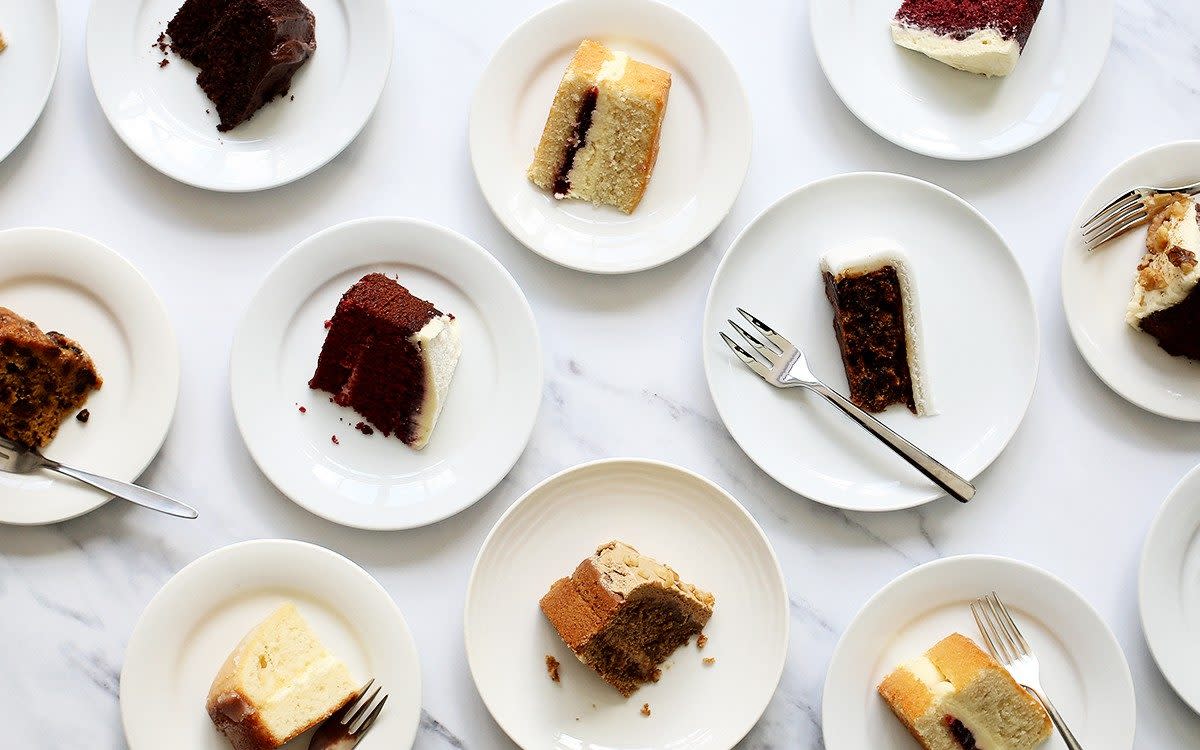
The English love cake. Fact. As registered dietitian Nichola Ludlam-Raine explains: “Cakes are often associated with celebrations, gatherings and afternoon tea, making them a core part of British social life, symbolising indulgence, comfort and community.”
But, obviously, they’re not good for us. A single modest slice can contain more sugar than the maximum recommended amount for an entire day, Ludlam-Raine warns, and when it comes to supermarket cakes, their blend of flavourings and additives means we often eat much more than we should.
However she concedes that “all food nourishes us in some way, whether it’s physiologically (like fruit, veg and whole grains), or emotionally and socially”.
In other words, cake is inevitable, so in honour of our love of cake we asked nutritionist Ludlam-Raine to analyse 50 cakes sold across five supermarkets (Tesco, Asda, Sainsbury’s, M&S and Waitrose) and pick out her choice of the best, the worst and the middling for each of the most popular types of cake, based on their nutritional profile, such as the amount of sugar and saturated fat they contain, as well as calorie content. Here’s our guide to the supermarket cakes that are best and worst for your health according to their nutritional description.
Which supermarket cake is best for your health?
Coffee & walnut
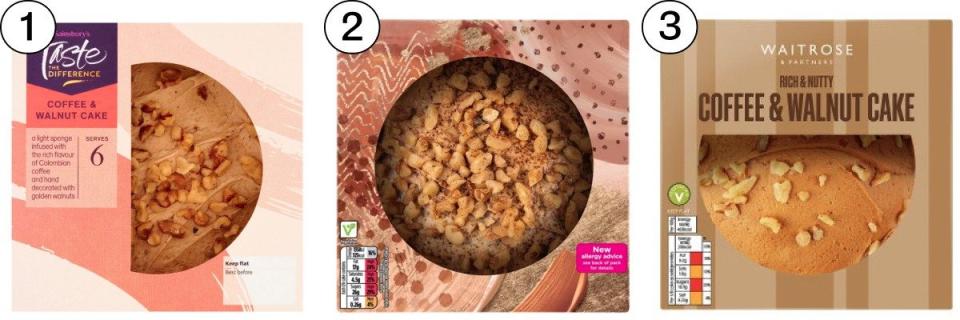
1. Healthiest
Sainsbury’s Colombian Coffee & Walnut Cake
With 420 calories, 20.9g of fat and 33g of sugar (per 100g), this cake has a balanced profile with lower sugar content compared to others. It also has a decent amount of protein (4.6g) and fibre (0.9g).
2. Middle of the road
Asda Extra Special Coffee and Walnut Cake
This cake has 436 calories and 23g of fat, placing it in the middle for calorie and fat content. It has a moderate sugar content (35g) and a relatively good amount of fibre (1.6g), which makes it a middle-ground choice.
3. Least healthy
Waitrose Coffee & Walnut Cake
While it has the lowest calorie content (403), it has the highest sugar content (37.9g) – an extra teaspoon per 100g in comparison with the Sainsburyʼs cake. The high sugar (and relatively low fibre) content makes it the least healthy choice despite its (slightly) lower calories.
Lemon drizzle
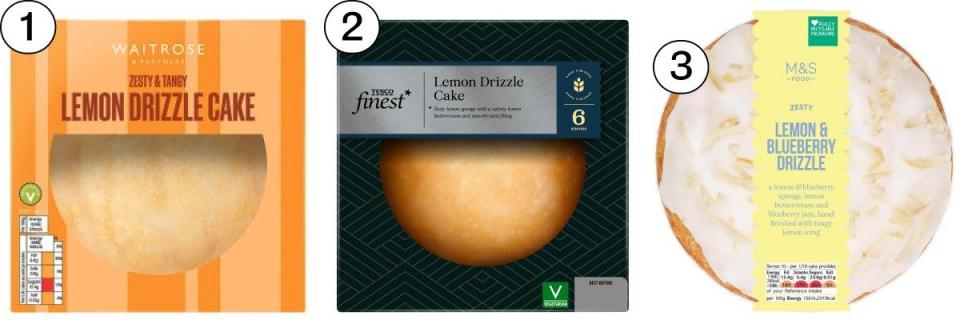
1. Healthiest
Waitrose Lemon Drizzle Cake
This option has 371 calories and 15.1g of fat (only 2.1g saturates), making it one of the lowest in both categories. It also has a relatively good balance of sugar (34.2g) and protein (3.8g), as well as the highest amount of fibre in this category (1.2g).
2. Middle of the road
Tesco Finest Lemon Drizzle Cake
With 387 calories and 16.3g of fat, this is a moderate choice. It has a balanced nutritional profile and a lower saturated fat content (3.5g) than most of the others, in addition to a relatively low sugar content (33.6g).
3. Least healthy
M&S Lemon & Blueberry Drizzle Cake
This cake has 390 calories and 15.3g of fat, but it stands out with the highest sugar content (44g). It is also higher in saturated fat (5.6g) than the other options.
Carrot cake

1. Healthiest
ASDA Extra Special Carrot Cake
With 381 calories and 18g of fat, this option has the lowest calorie count and balanced fat content. It also has a good amount of fibre (2.8g) and protein (3.3g). The sugar isn’t too excessive either (30g per 100g).
2. Middle of the road
Tesco Finest Carrot Cake
This cake has 386 calories and 17g of fat, making it a moderate option. It has a relatively balanced sugar (30g) and protein (4g) content too, in addition to 2.7g fibre.
3. Least healthy
Tesco Finest Free From Carrot Cake
This option has 412 calories and 20.5g of fat, making it the highest in both categories. It also has a higher saturated fat (4.7g) content compared with the other options.
Victoria sponge
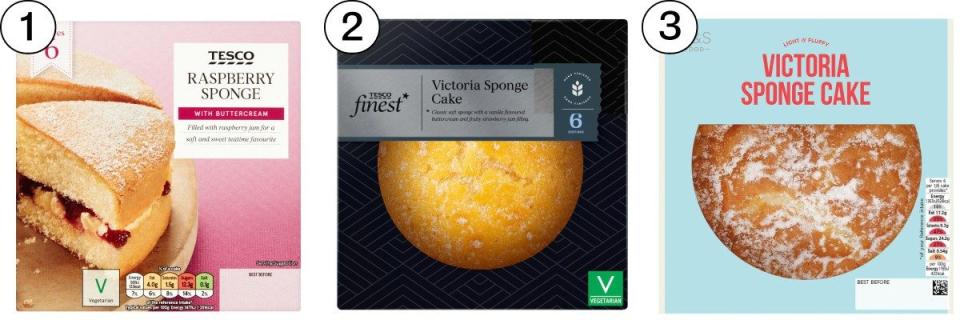
1. Healthiest
Tesco Raspberry Sponge Cake
With 351 calories and 10.4g of fat (with only 4g of saturated fat), this cake has the lowest calorie and fat content. It also has a lower sugar content (32.4g), making it the healthiest choice overall.
2. Middle of the road
Tesco Finest Victoria Sponge Cake
This cake has 405 calories and 19g of fat (with only 5g saturates), which is moderate compared with other options. It has a balanced sugar content (31g) and a relatively good amount of fibre (1.5g).
3. Least healthy
M&S Victoria Sandwich Cake
With 422 calories and 22.5g of fat (over 50 per cent of which are saturated), this cake has the highest calorie and fat content. It also has a high saturated fat content (12.1g) and very low fibre content, making it the least healthy option.
Fruitcake
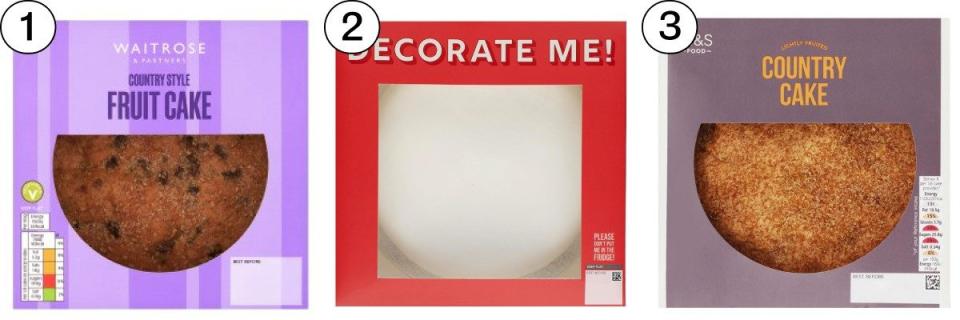
1. Healthiest
Waitrose Fruit Cake
This cake has 357 calories and 10.7g of fat, which although fairly middle of the road, the sugar content is the lowest at 37.1g per 100g, with a good amount of fibre (2.9g).
2. Middle of the road
M&S Iced Fruit Cake
With 354 calories and 7.7g of fat, this cake has the lowest calorie and fat content among the options listed. The sugar content, though, is the highest (43.2g) making it not the healthiest choice.
3. Least healthy
M&S Country Fruit Cake
With 393 calories and 15.4g of fat, this cake has the highest calorie and fat (and saturated fat) content. It also has a relatively high sugar content making it the least healthy option.
Chocolate cake
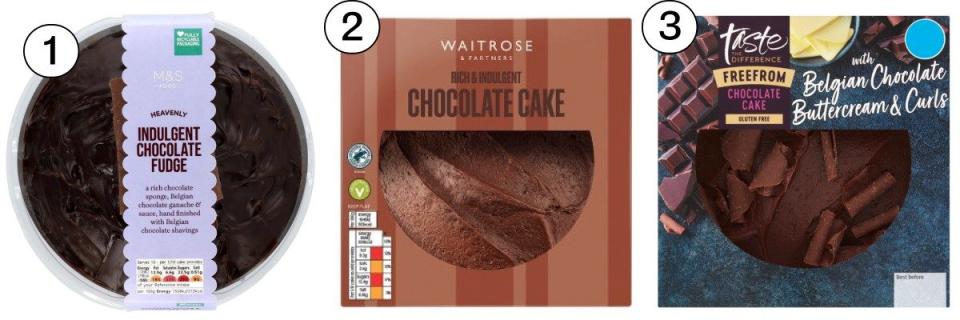
1. Healthiest
M&S Indulgent Chocolate Fudge Cake
With 372 calories and 17.2g of fat, this cake has the lowest calorie content and a moderate fat content. Despite a slightly higher sugar content (30g), it balances well with its lower overall calorie and fat profile, with pretty decent fibre content (2.3g) and protein too (5.5g).
2. Middle of the road
Waitrose Chocolate Cake
This cake has 393 calories and 17.9g of fat, making it a moderate option. It also has a lower sugar content (29.7g) compared with some others, balancing its nutritional profile well, with some fibre (2g per 100g) and protein too (5g per 100g).
3. Least healthy
Sainsbury’s Free From Chocolate Cake
With 424 calories and 22.2g of fat, this cake has the highest calorie and fat content. Though it has a moderate sugar content (30.4g), the lower protein content (3.6g) could make this cake much higher in the glycaemic index.
Red velvet
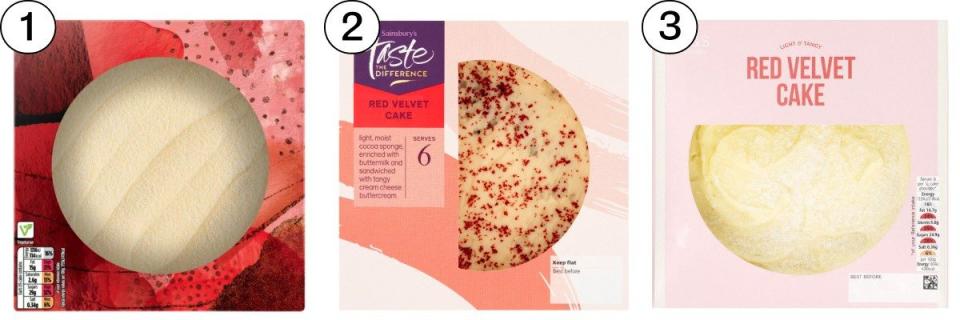
1. Healthiest
ASDA Extra Special Red Velvet Cake
With 419 calories and 20g of fat (only 3.4g saturates), this cake has the lowest calorie and fat content among the options. It also has a moderate sugar content (38g), and provides some fibre and protein too.
2. Middle of the road
Sainsbury’s Red Velvet Cake
This cake has 433 calories and 22.8g of fat, making it a moderate option. It has a balanced sugar content (30.7g) and lower saturated fat (6.6g) compared with some others (unsaturated fat is the preferred fat for health).
3. Least healthy
M&S Red Velvet Cake
With 438 calories and 23.1g of fat (almost 7g of which is saturated), this cake has the highest calorie and fat content. It also has a relatively high sugar content (34.3g), making it the least healthy option.
What’s inside your supermarket cake?
Sugar, butter, eggs and flour are the basic ingredients found in all cakes, as they provide structure, sweetness and moisture.
But that’s where the similarities between homemade and shop-bought end, as the latter contains ultra-processed ingredients (ones you wouldn’t have in your kitchen).
Preservatives are used to extend shelf life, prolonging how long it takes for a cake to become mouldy.
Flavourings, both natural and artificial, and palm oil are included to improve taste, while gelling agents are used to thicken and stabilise the texture. Finally, emulsifiers help blend ingredients together smoothly, preventing splitting.
Ingredients to look out for in your cake
While necessary for shelf life, some preservatives, such as sodium benzoate, have been found to cause adverse reactions in some people, says Ludlam-Raine.
Additionally, while the flavourings found in cakes are safe, because they make food taste better they can cause us to eat too much, she warns.
Cakes can also contain palm oil, which is full of saturated fat and can contribute to heart disease if too much is eaten over a prolonged period.
Gelling agents and emulsifiers are safe to consume in regulated amounts but can cause digestive discomfort in some people. “The research has predominantly been done in rodents but research in humans is underway, [showing that] high intake of three emulsifiers in particular [E433, E407 and E466] may be linked to inflammation of the gut and inflammatory bowel disease,” Ludlam-Raine says.
“If you find one of those three emulsifiers in a product that you eat regularly, try to reduce the frequency in which you eat it, or perhaps find an alternative,” she says. “But if it’s in a cake or product that you have occasionally, then that’s fine.”
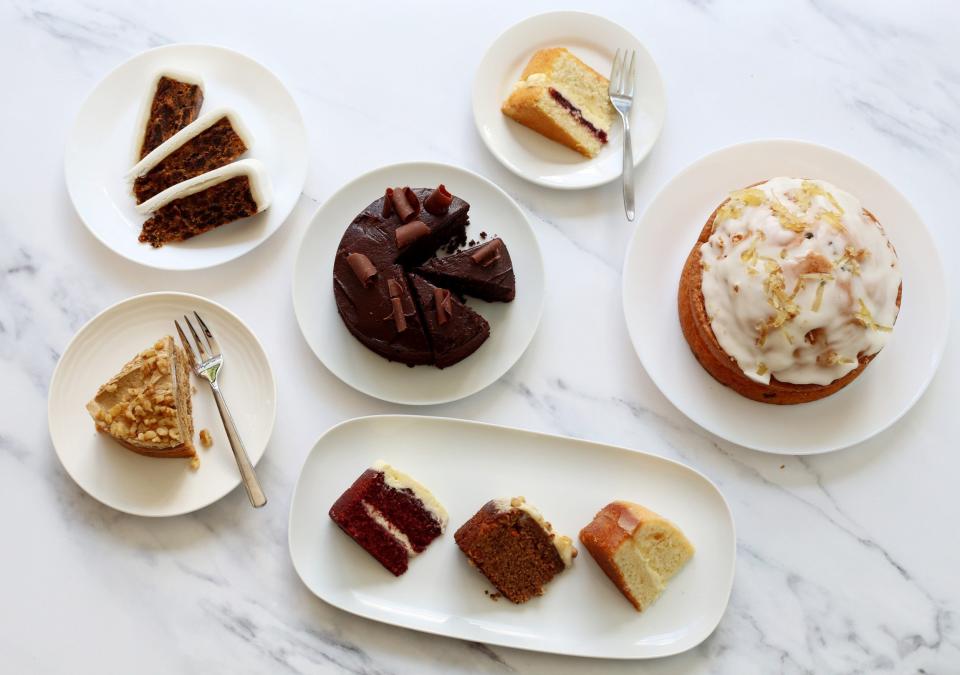
While most cakes contain a fair amount of sugar, watch out for high sugar content, as this can lead to tooth decay and weight gain if too much is consumed over time.
A way to avoid these ingredients is simply to bake your own cake at home. “You don’t create ultra-processed foods (UPFs) at home, so it’s always going to be best to make your own cake,” Ludlam-Raine says.
“You can then swap ingredients to make the cake healthier, like using wholemeal flour, freshly grated carrot (if it’s a carrot cake), nuts and less sugar,” she adds.
How much cake you should eat – and when
“While enjoying cake occasionally is perfectly fine, moderation is key to maintaining a balanced diet,” says Ludlam-Raine.
The NHS recommends that adults consume no more than 30g of free sugars per day, which are those added to foods, rather than those found naturally in milk, fruit and vegetables.
“Given that a typical slice of supermarket cake can contain 20-40g of sugar, it’s advisable to limit cake consumption to special occasions or once a week,” she says.
A correct portion size for cake would be around 70-100g, or the suggested serving size on the packaging. “But really, a larger slice of cake, or even having two small slices, on an infrequent basis, isn’t going to influence overall health,” Ludlam-Raine adds.
“You might get a blood sugar spike, followed by a ‘sugar crash’ from eating too much cake,” she explains. “Some people may also feel more lethargic after eating a high-fat and high-carbohydrate food like cake, because the body is working hard to digest it.”
When it comes to timing, it’s best to have it shortly after a meal as dessert, as the protein and fibre from your lunch or dinner slows down the digestion of the cake and the resultant blood sugar spike, Ludlam-Raine explains. Alternatively, you could go for a walk after eating cake, to limit the impact on glucose levels, she adds.
Ultimately, “if you really want a piece of cake, have it,” she says, “but put it on a plate, sit down, turn off the TV and enjoy it.”
“All foods can fit within our diet and all foods have a purpose, but it’s the portion size and the frequency in which you eat any type of food that determines how healthy you are.”
Nichola Ludlam-Raine (nicsnutrition.com, @nicsnutrition) is a specialist registered dietitian and author of How Not to Eat Ultra-Processed, which is published on July 18.

 Yahoo News
Yahoo News 
